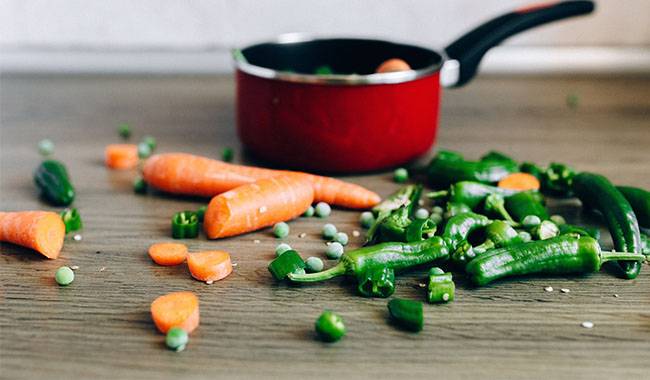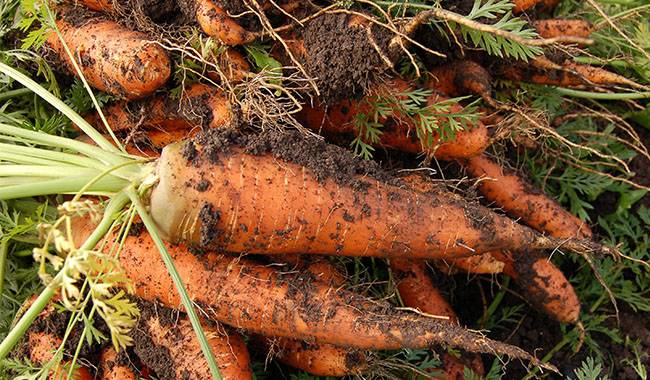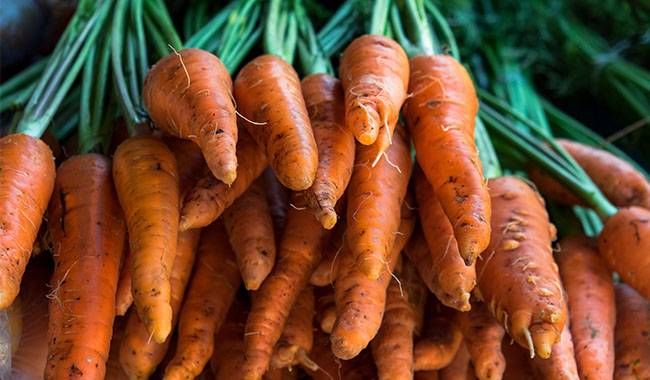
It is not without reason that the famous Renaissance physician and chemist Theophrastus Paracelsus called carrot root Mandragora (genus), making people live longer without diseases. The amazing properties of carrots lie in their carrot nutrition facts, which include various trace elements and a wealth of vitamins, some of which the human body cannot form during the metabolic process.
The root of the carrot concentrates substances that help treat many diseases, obtain a strong immune system and rejuvenate the entire body. Read more about the useful properties of carrots, their biochemical composition, and the influence of growing conditions on the value of the root crop in this material.
A FEW FACTS ABOUT CARROTS
Cultured carrots evolved from the wild carrots that grew in abundance in Asia and Europe. This root vegetable is thought to have originated in Afghanistan.
Carrots originated in Afghanistan and possibly northern Iran and Pakistan. Queen Anne’s Lace is a wild carrot that readily inter-pollinates with carrots and grows in temperate areas around the world where there is adequate moisture and disturbed ecology (roadsides, open spaces, etc.).
History of the carrot
The domestication of carrots took the following routes.
- 900 – 1000 AD: Purple and yellow carrots spread from Afghanistan to the eastern Mediterranean.
- The 1300s: purple and yellow carrots in Western Europe and China
- The 1600s: Yellow carrots in Japan
- The 1700s: In addition to purple and yellow, white carrots were reported in Europe, and orange carrots were first reported in the Netherlands and neighboring regions
- Today: orange carrots dominate worldwide, although some white types (for livestock) still exist in Western and Eastern Europe, some red (not orange) in Japan, some yellow and purple in the Middle East, and some purple, yellow, and red from Turkey to India and China
It should be noted that under natural conditions, the content and list of beneficial properties of root carrots differs from the cultivated form, where the beneficial properties of this crop are purposefully developed.
External review of key facts
- Carrot (Daucus carota) is a root vegetable of the Umbelliferae family, including celery, parsley, parsley, dill, parsley, fennel, coriander, and fennel.
- In 2012, the United States was the third-largest carrot producer. Approximately 80-90% of U.S. carrots are produced in California. Other major producers include Michigan and Texas.
In the late 1980s, the introduction of fresh-cut carrots and “baby carrots” created a carrot boom. - Carrots are rich in beta-carotene, vitamins C and K, potassium, and dietary fiber.
- Carrots are popular as a culinary vegetable, salad item, snack food, and raw vegetable.
- Like most vegetables, carrots are low in acid and therefore at high risk of contamination with Clostridium botulinum toxin, the bacterium produced by Clostridium botulinum, when improperly canned. There have been several outbreaks of botulism associated with commercial and homemade carrot juice and homemade canned carrots.
- Between 1998 and 2017, the CDC’s National Outbreak Reporting System (NORS) reported at least 31 carrot-related outbreaks resulting in 756 illnesses, 17 hospitalizations, and no deaths. In outbreaks of known etiology, the most common pathogen is norovirus, but also includes Bacillus cereus, Salmonella, Salmonella, Clostridium botulinum, Shigella, and Staphylococcus aureus.
It was not until the 20th century that breeding efforts produced carrot varieties with a predominantly orange color, high sweetness, and pleasant juicy flesh. Before breeding efforts, carrots were used primarily for cooking and much less frequently for root vegetables, but then there was a real culinary boom. Cookbooks devote considerable space to describing various recipes for cooking carrots with other grain crops, and medical reference books present recipes for preparing treatments for various ailments.
EFFECT OF CULTIVATION CONDITIONS OF CARROTS ON THE QUALITY OF ROOT CROPS
The value of carrots is determined by vitamins and other nutrients that accumulate in the root crop. Their quantity and quality depend on cultivation techniques. When agricultural practices are violated, changes occur not only in the exterior of carrots (small, sparse orange, cracked roots, etc.) but also in their biochemical indicators. Vitamins, flavonoids, anthocyanins, and other very important compounds are drastically reduced.
Carrot is a temperate crop. It has high requirements for basic living conditions: soil and temperature regime, provision of water, and light. The quality of root crops decreases due to insufficient soil preparation (low looseness, insufficient filling with basic fertilizers), insufficient watering and feeding during vegetation, violation of the ratio of the main nutrients (more nitrogen and less potassium), and other conditions.
When buying root crops in the market, be sure to ask about the growing conditions of the crop. But the best way to keep your family healthy is to grow carrots on your own plots, observing all the requirements of agricultural growing techniques. Also, only approved varieties and hybrids should be used when sowing seeds. During the winter period, list in your garden diary the early, middle, and late varieties with the highest biotechnical indicators of product quality and prepare carrot seeds of these varieties exactly.

BIOCHEMICAL COMPOSITION OF CARROTS
Vitamins in carrots
- Carrots contain 22% of pro-vitamin “A” (carotene), including alpha and beta carotene, which are synthesized in the body as vitamin “A,” and vitamin “A” is a guarantee of visual acuity.
- 100 grams of carrots contain more than 0.5 grams of B vitamins, including B1, B2, B3, B5, B6, B9, and B12, necessary for the synthesis of hemoglobin in the body.
- Carrot juice contains a group of active chemicals calcitriol, representing vitamin “D,” including “D2” and “D3”. Vitamin “D” can be produced in the body under the influence of natural sunlight and ultraviolet light (artificial irradiation) and manifests itself in the form of tanning. Deficiency in children manifests itself in the form of rickets and in adults in the form of osteoporosis (fragility) and softening of bones (osteopenia).
- Carrots have a high content of vitamin “K” (11%), which regulates blood clotting and prevents the formation of blood clots.
- Vitamins “C” and “E” provide energy and normalize the function of the endocrine glands. Vitamin E also slows down the aging process of the body. It is known as the vitamin of youth. It is vital for diabetics because it helps reduce the need for insulin.
- Vitamin “PP” (niacin), like the previous vitamins, provides energy to the body, supports heart function, blood circulation, and is involved in the metabolism of amino acids.
- Vitamin “N,” or lipoic acid, regulates the liver, thyroid, participates in the metabolism of carbohydrates, and influences the level of cholesterol in the blood.
The whole vitamin complex is preserved in freshly cooked carrot juice for one hour, after thawing – 0.5 hours. The complete utilization of the body occurs in the presence of fats (butter, sour cream).
Micronutrients in carrots
Carrots are characterized by a fairly high micronutrient content. In 100 grams of raw carrots, there is 320 mg of potassium, responsible for normalizing the heart. In Soviet times, athletes were prescribed potassium lactate. The sodium concentration was between 69-70 mg, and the sum of phosphorus and calcium exceeded 65-68 mg. Carrot root has sufficient copper, zinc, iron, magnesium, manganese, cobalt, and molybdenum.
Carrots also contain selenium, a young element, and fluorine, which is responsible for the thyroid gland and helps to remove heavy metals and radionuclides from the body.
Other elements are present in root crops and are compounds and combinations necessary for the normalization of water metabolism (chlorine), water-salt metabolism (sodium), and the composition of proteins (sulfur). Aluminum, boron, vanadium, nickel, chromium, lithium, and iodine complete the list of trace elements.
In the context of low-calorie products, an impressive list becomes indispensable for the treatment of obesity, weight loss, and stimulation of hematopoiesis.
Carrots are a part of all fitness diets. 100 grams of root crop (one small carrot) contains 35 to 40 kcal but contains more than 9.5 grams of carbohydrates and 2.8 grams of dietary fiber.
OTHER NUTRIENTS IN CARROTS
Recently, there has been a general decline in immunity in children and adults and increased cold and flu attacks. The phytotoxic properties of carrots are almost comparable to garlic and onions but without an unpleasant odor. On the contrary, the essential oils add spice to the dishes prepared.
In the early days of recognizing carrots as a food, as mentioned above, the seeds and green tops were used in cooking. The concentration is lower than in other vegetables, but a complete list of amino acids is present in carrots. These include tyrosine, lysine, leucine, ornithine, cysteine, asparagine, threonine, histidine, methionine, etc.
Carrot has a pleasant rich color due to its anthocyanins and bioflavonoids. It contains umbelliferone, which is involved in the biosynthesis of basic compounds such as phytosterols, coumarins, quercetin, fiber, pectin, and sugar.
USEFUL PROPERTIES OF CARROTS
For the treatment and prevention of diseases, carrot is available as a raw product, cooked, thawed, and frozen. In boiled form, it increases its positive impact on the body in treating nephritis, cancer, diabetes, and general flora disorders. Raw carrots prevent microbial infections of the mouth and systemic infectious colds (acute respiratory infections, influenza).
Carrot is used for vitamin deficiencies, anemia, atherosclerosis. It is included in formulas for treating Alzheimer’s disease, digestive tract, intestinal obstruction, cholelithiasis and urolithiasis, pyelonephritis, cystitis. Carrot juice is effective against conjunctivitis, night blindness, and other eye diseases. It is used in official and folk medicine to treat diseases of the bone and hematopoietic system.
Eating 50 grams of fresh carrots per day (average daily rate) will reduce the risk of stroke by 60-70%, breast cancer by 25%, and retinal diseases with visual impairment by 40%.
CONTRAINDICATIONS TO THE USE OF CARROTS
- Carrots are contraindicated in cases of hypersensitivity to this product.
- In inflammatory diseases of the gastrointestinal tract, small intestine, peptic ulcers. In these cases, the vegetable is used in the form of boiled or stewed.
- If you have liver disease, consult a doctor before consuming carrots.
- Yellowing of feet and skin in children and adults may occur if raw carrots and juice are consumed in excess. The daily dosage of this product should be reduced until the yellowing disappears.
Finally, I would like to warn the reader. Carrots are very useful, but at all need to be measured. It is enough to eat 1-2 carrots a day, no more than 100-120 grams of carrots in any form – salads, purees, juices.
More related information about planting & growing carrot plants







